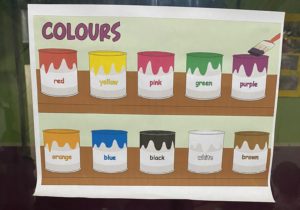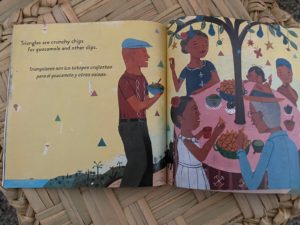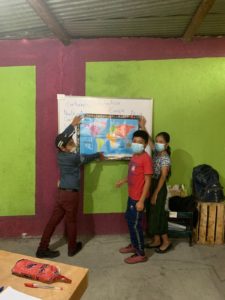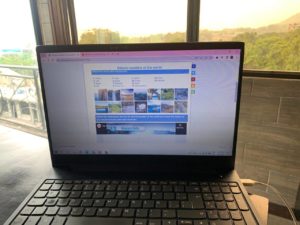All you need to know about how to teach English to kids
How to teach English to kids – 11 useful tips
Being fluent in English is one thing, but being able to teach it is a completely different game. If you learned English as a second language, it will be easier for you to empathise with the process and understand your students’ struggles, yet it is important to have some strategies in place to avoid falling down the route of copying and filling out grammar worksheets all day long.
Here we give you some tips on how to teach English to children.
11 useful tips to teach English to kids
If you have never taught English before, do not worry; we have some tips for you so you can start on the right foot teaching English to kids.
Note: Even though it is best to have some variety in your classes, you don’t have to constantly come up with new activities to teach English as it can be pretty exhausting as a teacher! If you find your students respond well and enjoy a set of games, go ahead and continue to use them, adjusting the difficulty level accordingly.
1. English only
Our first and most important tip is to speak English only throughout the class.
It is normal that children won’t understand at first, but don’t try to translate. Instead, use all the resources available to you to make yourself understood (mimicking, drawing, using flashcards…). Make it a game!
This will expose children to English and their brain will start assimilating words as concepts, as opposed to the exact translation. We are looking to develop their flexibility to understand the context of a sentence even when they only understand one or two words. Constantly translating brings rigidity to the brain and slows down the process of learning a language, stopping them from communicating when they don’t have the exact word they are looking for.
2. Encourage speaking – Eliminate pressure
From day one, encourage children to speak without the pressure of having to create perfect sentences. Create situations of need where children need to speak English, for example asking to go to the toilet, to come in when they are late, and keeping crayons and other resources with you so children need to ask to use them.
Don’t be afraid to write down the pronunciation of the word or sentence so they learn it right from the beginning (for example, the word ‘please’ would be pronounced as ‘pliis’ for a Spanish speaker). Always positively reinforce their speaking attempts; give a thumbs up, smile, and reply back accordingly. If possible, use token economy to encourage speaking, for example, during a class, a point or token is given for every correct intervention. The student that ends up with the highest number of tokens, wins.
3. Creating a routine
Since the whole lesson should be in English, creating routines helps children understand what comes next and facilitates the process of explaining activities and methodology. Start with greetings, perhaps write the date on the board depending on the age, and a quick review of what you learned in the previous class. Then, introduce the new topic, do an activity together followed by individual activity, summarise learnings and say goodbye.
4. Keep it fun and simple!
Scaffold concepts, from easiest to hardest. Break down the target of the lesson into simple concepts and use lots of repetition so that the students’ brain assimilates new words in different contexts.
Make sure activities are linked and increase in difficulty while using the same vocabulary, so the concepts within the lessons are assimilated. Don’t try to cover more than one target per lesson (i.e. vocabulary, grammar, speaking, etc) to avoid confusion.
5. Use visual support
Make use of flashcards and posters hung on the walls for students to visualise and repeat the new words targeted. To teach the colours, we have a poster hung on the wall so children need to go to the poster, read the colour they want, and come to where we keep the crayons to ask for that specific colour. Normally, the children love coming back and forth to the poster since they take it as a game.


Visual resources at our Learning Centre
6. Incorporate your students’ interests into lessons
Make it culturally relevant and age-appropriate. In our Guatemalan project, we are currently looking to teach all content with a Guatemalan perspective, which includes local animals, fruits and vegetables, or family flashcards representing Tz’utujil people with their traditional clothing.
Also, keep in mind their age and what is exciting for them at that age. For example, animals and fruits are a favourite amongst 8-year-olds, whereas describing famous people is engaging for teenagers (you will just need to do a bit of research on who is ‘cool’ for your audience!).

“Tortillas are round”, a book used to teach the shapes
7. Teaching English to kids? Use technology too!
As part of the routine, you can introduce vocabulary using videos in an engaging way. If Whatsapp is available, make sure you share the resources used in class afterward so they can review them at home. Depending on the size of the class, there is a myriad of digital activities to make learning fun.
8. Using music to learn English
Music is magic for children. It captivates their attention and makes them remember complex sentences. Use movement while you sing so they can identify the meaning of each sentence.
We usually sing a welcome song with the younger students (up to 10 years old) and sing a song related to the topic seen in class at the end of the lesson as a prize for good behaviour and a fun way to finish the class. Play with the speed of the song, start slowly and sing it faster and then slower so it is a game to keep the pace.
9. Use mnemonics strategies
Mnemonics are memory-enhancing strategies and are highly effective to help students learn and remember new vocabulary. Examples of these strategies are providing a picture or situation to relate to a new word, Pictionary, charades, or memory games with pair cards. This could be used to learn 8-10 words per lesson. Learning new words while reading a book will help recall the meaning of those words and associate them with the book.
Placing flashcards across the classroom will help with visualising and memorising new words as well, if possible try to place them in a logical way so it is easier for the brain to come up with a pattern. Another way is to draw the vocabulary by categories, for example, what’s in my bag? (notebook, book, ruler, pencil case…) What’s in my pencil case? (pen, pencil, crayons, eraser….)
Rhymes are another powerful way to remember new words and phrases. That is why songs are so effective. Head and shoulders or the alphabet songs are classics that help them learn in an easy way.
Using acronyms is useful too when the student needs to remember a particular combination of words, for example for older children there is the famous “My Very Educated Mother Just Served Us Noodles” to remember the order of the planets.
10. Games to learn English for kids
Everyone loves games, even adults. Use them to your advantage to practice your lesson target, whether that is pronunciation, learning vocabulary, or reviewing grammar. Adjust the game to practice the area you are working on.

A children’s English lesson at our Learning Centre
Role-play games!
Role-play games are a great way to practice speaking, for example, greetings, shopping in the market, giving directions, describing people and so on. We love mimicking and playing taboo to review vocabulary.
Play “Simon Says” to teach English
Simon says, Teacher says is very versatile and children from all over the world quickly understand the game. We use it to review the parts of the body but also movement actions like sit down, stand up, jump, run, clap your hands. It is a great game that combines learning and movement.
Do you need a bit more inspiration? Have a look at the list our English teacher volunteers have put together to teach English to kids.
11. Outdoor activities to learn English
Using outdoor spaces is another way to make learning fun and engaging for children. There are many activities that can be done outdoors from telling a story in the garden, to writing words on the ground, to running games like “Steal the Flingsock”. Just make sure you have your target clear.
What is the best way for kids to learn English?
Learning a language is in itself a game that requires logic and many internal resources to decipher what the other person is saying and make yourself understood. Try to look at it this way so in every lesson you provide opportunities for your students to practice their detective and problem-solving skills.
Use visuals to provide cues, be engaging to create interest in what you are talking about and the need to use English, always trying to cater to their interests in the activities planned. Body language is one of your best resources to be engaging and to help scaffold your classes at the same time.
Play with your pace; a slower pace helps students understand complex concepts while a faster pace makes it fun once they have understood the goal of the activity. Use cooperative learning; offer peers to lead the activity, choose who is next in the game or the next word to guess. Use healthy competition as a way to lift the class’s energy and increase the pace of the activity.
An English Lesson Example
Find below a little example of one of our lessons at One, Two… Tree!
I’m Teacher Gracia. I’ve been volunteering with One Two… Tree! for a year, and this was a lesson I planned for our teen group at the Center (kids between 10-14 years old) to learn about the Natural Wonders of the World.

Teaching English in Santiago Guatemala
Every day, we start by taking attendance during the first 5 minutes which is a good excuse to practice greetings and common courtesy like “Hello, Good afternoon, How are you today?”.
Then, I like to start with an activity or something interactive to get the students engaged right away.
We had previously learned a song in our Countries and Continents lesson which went well, so before the class, I searched for a few new songs on YouTube and I found one that I thought the students would love. I brought my phone to class, then I played the song a few times and asked the students to write down the lyrics in their notebooks. They absolutely loved it!
After that, for each new lesson in the Wonders of the World module, we would sing together to start the class: They are Asia and Africa, North and South America, Antarctica and Europe, finally Australia.
After this activity, I handed them a worksheet about the “Natural Wonders of the World” (a free worksheet I downloaded from an educational website www.liveworksheets.com). We read the new words, practicing the pronunciation and learned the meaning. Then the students had time to complete the worksheet, matching the pictures with words such as forest, cave, river, and more.

English lesson planning
For this lesson, I also needed a computer to show the students a video about the 8 wonders of the world, so I brought my laptop. I put subtitles in English and after each place was featured in the video, I paused it to give the students time to match each place like Niagara Falls, Mount Everest, and the Amazon River, with the country they are located in on their corresponding worksheet. This helped the students practice the new vocabulary in different ways and solidified their understanding of the concepts through interactive methods.

Teaching English in Guatemala
We always finish the class talking about the topic we learned or playing a game and having a good time. Once the hour is finished, we say goodbye and see you next time!
Does this sound fun and interesting to you?
We are seeking more English teacher volunteers to come to Santiago Atitlán, Guatemala, to help us expand our programs, reach, and impact on the community.
If you would like to learn more about volunteering with us, please send us an email at: guatemala@onetwo-tree.com, complete the form on our website, or contact us through Instagram @onetwotreengo.
FAQs as an English teacher volunteer
Here are some of the most frequent questions people have when thinking about teaching volunteering:
What causes poor performance in English?
There might be different causes for poor performance, one that is key to address early on is lack of interest, boredom and motivation. Learning English requires effort and being able to master it it’s a long journey, students need to want to learn to go through the effort. With children, you will achieve this by using games that they want to play. As they grow up it is important to identify their interests and goals to relate them to their English practice.
Lack of repetition and practice to fully assimilate one topic, not scaffolding concepts correctly or lack of English foundation background when working with more complex structures and activities, can make students think it is impossible to learn English and switch off. Trying to teach too much at once and focusing too much on grammar with little practice will likely overwhelm your students.
If you identify students with a much lower level than the rest of the class you can either bring extension activities for the more able students while you reinforce the basics or create a small tutoring group (no more than 5 students) to bring them up to speed.
Another common cause for poor performance is fear of making mistakes especially when practicing speaking. Having enough vocabulary helps you feel a bit more confident as well as a reinforcing environment where speaking is encouraged and mistakes are normalised as part of the learning process.
Lastly, a very common cause in non-English speaking countries is the lack of exposure to English-only classes and interactions. Having an English lesson mostly taught in the students’ mother tongue will only slow down the learning journey as there is no opportunity nor motivation to put the language skills into practice.
What are the difficulties in learning English?
Here are some of the most common difficulties when learning English:
- Spelling. Many words that are otherwise unrelated and are spelled differently sound the same when spoken (for instance, “pair” vs “pear”)
- Pronunciation. Especially for students whose native language is pronounced as written, like Spanish. English pronunciation doesn’t always follow the same rules like different vowel pronunciations “island vs igloo”
- Idioms and slang.
- Variations of the language and different accents. Chips or fries? Movie or film? Lift or elevator? Colour or color?
- Feeling Embarrassed and lack of confidence
- No interaction with native speakers
In addition, it is important to explain to your students that learning English, and any other language, is not linear. In the beginning, they will see their progress as they start assimilating different topics. However, there is a point where the brain is trying to speak without consciously preparing each sentence that the student will feel like going backward. It is a signal of progress! That is the time to increase speaking practice and be involved in situations requiring English.
How can I convince my students to speak English?
Generally speaking, there are two factors that affect students’ speaking English in class. One is they fail to find suitable words to express themselves and the other is they are afraid of making mistakes. A friendly, fun and relaxed environment helps the students to speak actively and correctly.
Some tips to get your students to speak in English:
- Give clear goals and instructions
- Be firm in a gentle way as some students will only dare to speak if asked to. It is important to spot those more shy students to ensure the class includes everyone. Yet be mindful to give plenty of time and support so they don’t feel put on the spot.
- Positively reinforce any attempt at speaking.
- Do small talk every day to keep practicing
- Always add unexpected factors so they need to think and respond to the stimulus instead of replying mechanically
- Make use of competition.
- Relate the practice to real-life situations. If possible make your students interact with native speakers or simulate the situation. For example, set up an exchange with a school in another country so they have to use English to get to know other students. Take your students to an activity where all the participants only speak English for example having a picnic, going to the market, or visiting an exhibition.
How do you help students who can’t speak English?
Eventually, all students will end up speaking English, it is just a matter of time. In the meantime:
- Be patient
- Praise any attempt to communicate in English and answer/act accordingly so they can see their progress and not wait to have the perfect sentence to speak.
- Leverage background knowledge. Identify early on any gaps
- Provide visual support and use loads of body language
- Model comprehensible language
- Purposefully pair peers of varying English proficiency to increase chances to practice their language skills, working together to support each other while English-proficient students can model language and provide personalized feedback.
What should I teach a child first in English?
Remember when teaching English to children that for them it is the start of their English journey hence it is important to break it down into manageable chunks that they can put together as they grow up.
In order to know where to start or what activities to plan, be mindful of your student’s age so you can adapt to their learning capacity.
- From preschool, until they learn how to read and write, it is all about learning vocabulary, commands and songs so they can develop their listening skills, and assimilate new words and simple sentences to repeat and use in their day to day. Useful topics at this age are:
- numbers (1–10; 10–20; 20–100)
- colours and shapes
- adjectives (e.g. big, small, tall, happy, sad, tired)
- the body
- toys
- clothes
- animals (e.g. pets, farm animals, wild animals)
- food
- emotions
- From 7 to 10 years old you can start practicing a bit of writing and reading but keep it simple. Encourage loads of role play and little dialogues at this stage to get them a bit more confident in their speaking. Here you can expand the above topics to:
- family
- house rooms and furniture
- classroom items
- months and seasons
- nature
- From 10 to 14 years old you can incorporate more complex sentences in all areas of English. There is no need to explicitly teach grammar rules, but instead get them used to hearing and using different grammatical structures in context. Hearing the grammar being used in context from an early age will help children to use it naturally and correctly when they are older. Useful topics at this stage are:
-
- daily routine
- self-description and describing others
- hobbies and interests
- jobs
- festive holidays and traditions









